Outdoor River Activities: Relations with Geological Background and Extreme Events in the Perspective of Geoeducation
Abstract
1. Introduction
2. Study Area
- (i)
- the Kinzigite Formation (Late Proterozoic–Early Paleozoic), a metamorphosed volcano–sedimentary sequence with mantle peridotite lenses, tectonically interfingered with the metasedimentary rocks near the CL (Balmuccia in the Sesia Valley) [35];
- (ii)
- the Mafic Complex (Carboniferous-Permian), representing the deepest level of the Sesia Magmatic System, intruded during the Early Permian in the Kinzigite Formation. It is an 8 km thick composite layered body, whose intrusion lasted for 6 Ma, starting 288 Ma ago [30,36]. In the study segments of the Sesia river, it is constituted by four main subunits, amphibolite gabbro, gabbro and norite, Val Sesia diorite, and cumulus ultramafic rocks, the latter cropping out in thin layers.
The Hydrogeological Event of 2–3 October 2020
3. Materials and Methods
3.1. Selection of River Segments
3.2. River Reaches Determination and Classification
3.2.1. Characterization of the Fluvial System according to IDRAIM
- (i)
- Bedrock features—according to the IDRAIM method, the distinction between rock types is related to the susceptibility of rocks to water erosion. In our specific case, the area features metamorphic rocks, which, if apparently similar, show different resistances to erosion, producing different kinds of fluvial landforms. In order to analyse this factor, the map by Quick et al. [45] (1:25,000 spatial scale) was used for the Sesia river segments (GS-CS), while the lithology was derived from the shapefile available from the Piemonte region WebGIS services for the Sorba stream (CNS) (Table 2), with a resolution of 1:100,000. Moreover, the information was also compared with a geological map of the Sesia Val Grande UGGp ([30]; Figure 2). The 3 segments were divided into traits, considering the lithological contacts between units when significant and influent on fluvial morphology.
- (ii)
- Confinement Degree and Index—the Confinement Degree (DC) represents the percentage of the length of the reach not in contact with the alluvial plain but confined by rocks. Confined traits are usually more than 90% bordered by slopes and ancient morphological elements (e.g., fluvial terraces), while, on the contrary, unconfined traits are less than 10% in contact. The Confinement Index (IC) is calculated as the ration between the alluvial plain width, including the bankfull channel, and the bankfull channel width. Confined settings show the IC composed between 1 and 1.5, while the confinement index is considered medium-to-low for values greater than 1.5. Combining the 2 values, the final confinement class is determined.
- (iii)
- Sinuosity Index (IS)—this index is calculated only for single channel traits as the ratio between the length of the bankfull axe and the length of the valley axe. A straight reach is defined with a IS lower than 1.05, the reach is sinuous if the IS is between 1.05 and 1.15, and it could be classified as meandering if even greater.
- (iv)
- Bankfull bottom configuration—the distinction between those with a rocky bottom and alluvial or semi-alluvial bottom reaches was also made. To distinguish between the categories, the continuity of the alluvial material or rock is important. This property is related to flow energy and steepness of the bottom.
- (v)
- Morphological unit definition—rafting and canyoning are strictly dependent on specific morphologies such as cascades, rapids, riffles, glides, steps, and pools. Along rafting reaches, it is improbable to find cascades and steps, while it is possible to meet all the morphological conditions along canyoning reaches. The morphological units were defined according to IDRAIM classification.
- (vi)
- Steepness of the bankfull bottom—the altitude profile of the river bottom was finally extracted from the Digital Terrain Model (DTM—5 m resolution, Table 2) using the “3D Analyst tool—Interpolate” line of ArcGIS 10.2.1. These data were used to especially confirm morphological units along the investigated segment. Since the DTM with 5 m resolution is relative to the 2009–2011 time interval, in a dynamic environment such as a fluvial environment, the differences that occurred in a 10-year time interval (from the DTM survey and the current analysis) could be very significant, as discussed in the results.
3.2.2. Classification of Rafting Features (i.e., Rapids, Riffles, and Glides) and Canyoning Reaches according to the Difficulty Degree
3.3. Analysis of the Effects of the 2020 Extreme Meteorological Events on Fluvial Morphologies
4. Results
4.1. Characterization of the Fluvial System according to IDRAIM and Classification of Rafting Features
- (i)
- Bedrock features—The GS and the CS segments are totally included in the Sesia Supervolcano area. The CNS, instead, is located within the Austroalpine Domain. The units incised by Sesia River in the study section belong mainly to the Canavese Zone and to the Mafic Complex. The contact between the Canavese Zone and Mafic Complex corresponds to the Insubric Line. The Canavese Zone’s rocks are characterized by mylonite structures in greenschist facies, intensively deformed and foliated as a consequence of the Insubric Line action. The rocks of the Mafic Complex are less susceptible to erosion, even if the local occurrence of fractures may increase this property. Moreover, the Balmuccia peridotite (pre Permian mantle rock) represents a strong obstacle to incision by the river. Five main reaches were detected along the GS, which, according to Quick et al. [45], run along the Insubric Line crossing it three times. GS-G-A and GS-G-E flow into mylonite (22.80%), GS-G-B (Figure 4a), GS-G-D, and GS-G-F run into amphibolite gabbro (77.20%), and a very short reach in the middle (GS-G-C) flows across an ultramafic cumulite. The river morphology is characterized by the presence of a beautiful gorge in correspondence of the amphibolite gabbro and ultramafic cumulite. This morphology is related to rock resistance, and the location of the incision could have been favoured by the presence of a weakness line. Along the reaches GS-G-E and F, the mylonite and amphibolite gabbro are covered in the [45] map by Quaternary deposits of different ages: older fluvial terraces or more recent alluvial deposits.
- (ii)
- Confinement Degree and Index—The three investigated segments present variable confinement degrees and indexes (Figure 5 and Figure 6a), with some reaches completely confined by rocks, showing impressive gorges that allow rafting or canyoning. The CNS segment (CNS-C-A) is totally confined (Figure 5a). The GS segment (Figure 5b), as the name itself shows, is confined for more than the 80% of its 1908 m total length. A gorge characterizes the longest portion of the GS segment (GS-C-A; length of 1241 m, 65.04%), and the river is confined (IC = 1). The other portion of the GS (GS-C-B; length of 667 m, 34.96%), ending in the correspondence of the Balmuccia alluvial fan, is featured by a medium confinement (IC = 2.68). The CS (Figure 5c) is quite variable in terms of confinement. In particular, there was a first confined reach with an IC of 1 (CS-C-A, length 770 m, 9.35%), and, after, there are 2 medium confined reaches with ICs between 1.92 and 4.7 (GS-C-B and C, lengths of 363 and 7105 m, respectively, for a total of 90.65%).
- (iii)
- Sinuosity Index—The IS of the first reaches of both the CS (CS-S-A; 13.75%) and CNS (CNS-S-A; 100%) (IS = 1.05) indicates a straight pattern (Figure 6b). The entire GS (GS-S-A; 100%) is sinuous (IS = 1.15). The second portions of the CS (CS-S-B; 86.25%) is slightly sinuous (IS = 1.13). This sinuous reach is also medium confined, while the GS sinuous segment is confined to the medium confined. A straight pattern could possibly be associated with a structural control on landforms.
- (iv)
- Bankfull bottom configuration—The three investigated segments are characterized by alternating semi-alluvial and rocky bottoms. The GS is featured in the middle part for more than a half of its length (55.82%) by a rocky gorge carved in the Mafic Complex rocks (GS-B-B; Figure 6c). The rocky gorge of CS (CS-B-A; 5.90%; Figure 6c) is incised within the Balmuccia peridotite layer. Then, the two rocky steps along the Sorba segment are carved in Gneiss Minuti (CNS-B-B and D; 53.65%; Figure 6c). The remaining reaches (46.35%; Figure 6c) are semi-alluvial with recent alluvial deposits or ancient terraces and only sparse boulders.
- (v)
- Morphological unit definition—As evidenced by the graphs in Figure 7, the variability of the morphological units is different, by one segment in respect to the others. As emerged from the spatial distribution shown in Figure 8, and as described before, morphology types alternate along the segments. The greatest variation regards the presence of morphological steps, more recurrent in the CNS (20.20%), where canyoning is practiced, with respect to GS (1.10%) and CS, where, in the last one, they are totally absent. For this reason, rafting there is not practicable. The presence of steps along the CNS may be connected to the occurrence of minor faults transverse to the river flow. The river energy produced in correspondence of the steps is translated in a greater erosive capacity by the river and in the consequent genesis of a pool. Concerning pools, they are the most recurrent morphology along the GS (47.96%), followed by rapids (35.74%). Rapids and pools alternate along the gorge (GS-C-A, GS-S-A), and their high hydrodynamic energies do not favour the debris accumulation, and the morphologies of the riffles and glides is not usual. Riffle and glide morphologies feature only 15.20% of the GS, along the semialluvial portion (GS-C-B, GS-S-B) and as far as the steepness increase nearby Balmuccia. Along the CS pools, rapids, riffles, and glides are similarly represented (32.36% to 33.82%). They alternate quite regularly all along the segment. Rapids and cascades feature an important part of the CNS (33.15%), and 29.75% are characterized by riffles and glides.
- (vi)
- Steepness of the reaches
4.2. Effects of the 2020 Extreme Meteorological Events on Fluvial Morphologies and Rafting and Canyoning Difficulty Degree
5. Discussion
5.1. River Outdoor Activities and Geological Time Scale Processes
5.2. River Outdoor Activities and Short Time Scale Events: The Case of the 2020 Event
5.3. River Outdoor Activities for Geoeducation Opportunities
6. Conclusions
Supplementary Materials
Author Contributions
Funding
Acknowledgments
Conflicts of Interest
References
- Pelfini, M.; Bollati, I. Landforms and geomorphosites ongoing changes: Concepts and implications for geoheritage promotion. Quaest. Geog. 2014, 33, 131–143. [Google Scholar] [CrossRef]
- Brilha, J. Geoheritage: Inventories and evaluation. In Geoheritage; Elsevier: Amsterdam, The Netherlands, 2018; pp. 69–85. [Google Scholar] [CrossRef]
- Bollati, I.M.; Crosa Lenz, B.; Caironi, V. A multidisciplinary approach for physical landscape analysis: Scientific value and risk of degradation of outstanding landforms in the glacial plateau of the Loana Valley (Central-Western Italian Alps). Ital. J. Geosci. 2020, 139, 233–251. [Google Scholar] [CrossRef]
- Gordon, J.E.; Wignall, R.M.; Brazier, V.; Crofts, R.; Tormey, D. Planning for Climate Change Impacts on Geoheritage Interests in Protected and Conserved Areas. Geoheritage 2022, 14, 126. [Google Scholar] [CrossRef]
- Palomo, I. Climate change impacts on ecosystem services in high mountain areas: A literature review. Mt. Res. Dev. 2017, 37, 179–187. [Google Scholar] [CrossRef]
- Gordon, J.E.; Crofts, R.; Gray, M.; Tormey, D. Including geoconservation in the management of protected and conserved areas matters for all of nature and people. Int. J. Geoheritage Park. 2021, 9, 323–334. [Google Scholar] [CrossRef]
- Gray, M. Geodiversity: Valuing and Conserving Abiotic Nature, 1st ed.; John Wiley and Sons Ed.: Oxford, UK, 2004; p. 448. [Google Scholar]
- Zouros, N. The European Geoparks Network. Geological heritage protection and local development. Episodes 2004, 27, 165–171. [Google Scholar] [CrossRef]
- Sustanable Development Goals. Available online: https://www.un.org/sustainabledevelopment/sustainable-development-goals/ (accessed on 28 March 2023).
- Witty, S. Bergsport als Gefährdungsfaktor für Pflanzen und Tiere—Tendenzen und Schutzmöglichkeiten. Schr. Für Veg. 1998, 29, 261–273. [Google Scholar]
- Orion, N. A Model for the development and implementation of field trips as an integral part of the Science curriculum. Sch. Sci. Math. 1993, 93, 325–331. [Google Scholar] [CrossRef]
- Bollati, I.M.; Crosa Lenz, B.; Zanoletti, E. A procedure to structure multidisciplinary educational fieldworks for understanding spatio-temporal evolution of the Alpine landscape. Rend. Online Soc. Geol. Ital. 2019, 49, 11–19. [Google Scholar] [CrossRef]
- Ruban, D.A.; Ermolaev, V.A. Unique Geology and Climbing: A Literature Review. Geosciences 2020, 10, 259. [Google Scholar] [CrossRef]
- Garlick, S. Flakes, Jugs, and Splitters: A Rock Climber’s Guide to Geology; Rowman & Littlefield: Lanham, MD, USA, 2009. [Google Scholar]
- Bollati, I.; Zucali, M.; Giovenco, C.; Pelfini, M. Geoheritage and sport climbing activities: Using the Montestrutto cliff (Austroalpine domain, Western Alps) as an example of scientific and educational representativeness. Ital. J. Geosci. 2014, 133, 187–199. [Google Scholar] [CrossRef]
- García-Rodríguez, M. Educación ambiental y deporte. Cómo la geomorfología condiciona la escalada. El ejemplo de la Pedriza del Manzanares (Madrid). Ensen. Cienc. Ti. 2015, 23, 320–329. Available online: http://www.raco.cat/index.php/ECT/article/view/306540/396520 (accessed on 28 March 2023).
- Bollati, I.; Fossati, M.; Zanoletti, E.; Zucali, M.; Magagna, A.; Pelfini, M. A methodological proposal for the assessment of cliffs equipped for climbing as a component of geoheritage and tools for Earth Science education: The case of the Verbano-Cusio-Ossola (Western Italian Alps). J. Virtual Explor. 2016, 49, 1–23. Available online: http://virtualexplorer.com.au/journal/2016/49 (accessed on 28 March 2023).
- García-Rodríguez, M.; Fernández-Escalante, E. Geo-Climbing and environmental education: The Value of la Pedriza granite massif in the Sierra de Guadarrama National Park, Spain. Geoheritage 2017, 9, 141–151. [Google Scholar] [CrossRef]
- Bollati, I.M.; Gatti, C.; Pelfini, M.P.; Speciale, L.; Maffeo, L.; Pelfini, M. Climbing walls in Earth Sciences education: An interdisciplinary approach for the secondary school (1st level). Rend. Online Soc. Geol. Ital. 2018, 44, 134–142. [Google Scholar] [CrossRef]
- Senese, A.; Pelfini, M.; Maragno, D.; Bollati, I.M.; Fugazza, D.; Vaghi, L.; Federici, R.; Grimaldi, L.; Belotti, P.; Lauri, P.; et al. The Role of E-Bike in Discovering Geodiversity and Geoheritage. Sustainability 2023, 15, 4979. [Google Scholar] [CrossRef]
- Baláš, J.; Giles, D.; Chrastinová, L.; Kárníková, K.; Kodejška, J.; Hlaváčková, A.; Vomáčko, L.; Draperet, N. The effect of potential fall distance on hormonal response in rock climbing. J. Sport. Sci. 2017, 35, 989–994. [Google Scholar] [CrossRef]
- Siegel, S.R.; Fryer, S.M. Rock climbing for promoting physical activity in youth. Am. J. Lifestyle Med. 2017, 11, 243–251. [Google Scholar] [CrossRef] [PubMed]
- Hrušová, D.; Chaloupská, P. Experiencing in Climbing and Psychological Effects of Sport Climbing. In Proceedings of the 7th icCSBs 2018 the Annual International Conference on Cognitive-Social, and Behavioural Sciences, Moscow, Russia, 14 November 2018; pp. 118–126. [Google Scholar] [CrossRef]
- Panizza, V.; Mennella, M. Assessing geomorphosites used for rock climbing. The example of Monteleone Rocca Doria (Sardinia, Italy). Geogr. Helv. 2007, 62, 181–191. [Google Scholar] [CrossRef]
- Picazzo, M.; Brandolini, P.; Pelfini, M. Clima e Rischio Geomorfologico in Aree Turistiche; Pàtron Editore: Bologna, Italy, 2007; p. 356. [Google Scholar]
- Motta, L.; Motta, M. La valutazione del rischio geomorfologico negli sport all’aria aperta: L’esempio del canyoning. In Clima e Rischio Geomorfologico in Aree Turistiche; Pàtron Editore: Bologna, Italy, 2007; pp. 295–320. [Google Scholar]
- GeoRafting—Experiencing Geology. Available online: https://fb.watch/hdHKDPaEDi/ (accessed on 28 March 2023).
- Gulas, O.; Vorwagner, E.M.; Pásková, M. From the orchard to the full bottle: One of the geostories of the Nature & Geopark Styrian Eisenwurzen. Czech J. Tour. 2019, 8, 143–155. Available online: https://sciendo.com/pdf/10.2478/cjot-2019-0009 (accessed on 28 March 2023).
- Perotti, L.; Carraro, G.; Giardino, M.; De Luca, D.A.; Lasagna, M. Geodiversity evaluation and water resources in the Sesia Val Grande UNESCO Geopark (Italy). Water 2019, 11, 2102. [Google Scholar] [CrossRef]
- Perotti, L.; Bollati, I.M.; Viani, C.; Zanoletti, E.; Caironi, V.; Pelfini, M.; Giardino, M. Fieldtrips and Virtual Tours as Geotourism Resources: Examples from the Sesia Val Grande UNESCO Global Geopark (NW Italy). Resources 2020, 9, 63. [Google Scholar] [CrossRef]
- Luino, F. L’evento alluvionale del 2–3 ottobre 2020 in Piemonte. Geologia Dell’ambiente 2021, S4, 180. [Google Scholar]
- Pistone, M.; Müntener, O.; Ziberna, L.; Hetényi, G.; Zanetti, A. Report on the ICDP workshop DIVE (Drilling the Ivrea–Verbano zonE). Sci. Dril. 2017, 23, 47–56. [Google Scholar] [CrossRef]
- Steck, A.; Della Torre, F.; Keller, F.; Pfeifer, H.-R.; Hunziker, J.; Masson, H. Tectonics of the Lepontine Alps: Ductile thrusting and folding in the deepest tectonic levels of the Central Alps. Swiss J. Geosci. 2013, 106, 427–450. [Google Scholar] [CrossRef]
- Zucali, M.; Spalla, M.I. Prograde Lawsonite During the Flow of Continental Crust In The Alpine Subduction: Strain vs. Metamorphism Partitioning, A Field-Analysis Approach to Infer Tectonometamorphic Evolutions (Sesia-Lanzo Zone, Western Italian Alps). J. Struct. Geol. 2011, 33, 381–398. [Google Scholar] [CrossRef]
- Quick, J.E.; Sinigoi, S.; Mayer, A. Emplacement of mantle peridotite in the lower continental crust, Ivrea-Verbano zone, northwest Italy. Geology 1995, 23, 739–742. [Google Scholar] [CrossRef]
- Sinigoi, S.; Quick, J.E.; Demarchi, G.; Peressini, G. The Sesia Magmatic System. J. Virtual Explor. 2010, 36, 1–33. [Google Scholar] [CrossRef]
- Quick, J.E.; Sinigoi, S.; Peressini, G.; Demarchi, G.; Wooden, J.L.; Sbisà, A. Magmatic plumbing of a large Permian caldera exposed to a depth of 25 km. Geology 2009, 37, 603–606. [Google Scholar] [CrossRef]
- Arpa Piemonte. Eventi alluvionali In Piemonte—Evento Del 2–3 Ottobre 2020, Technical Report, Torino. 2020, p. 99. Available online: http://www.arpa.piemonte.it/pubblicazioni-2/relazioni-tecniche/analisi-eventi/eventi-2020/2020-rapporto-evento-02-ottobre.pdf (accessed on 28 March 2023).
- Cassardo, C.; Loglisci, N.; Paesano, G.; Rabuffetti, D.; Qian, M.W. The hydrological balance of the October 2000 flood in Piedmont, Italy: Quantitative analysis and simulation. Phys. Geogr. 2006, 27, 411–434. [Google Scholar] [CrossRef]
- Regione Piemonte. Gli Eventi Alluvionali Del Settembre-Ottobre 1993 in Piemonte. 1996. Available online: https://www.arpa.piemonte.it/approfondimenti/temi-ambientali/geologia-e-dissesto/pubblicazioni/immagini-e-files/ev93 (accessed on 28 March 2023).
- Regione Piemonte. Eventi Alluvionali in Piemonte. 2–6 Novembre 1994. 8 Luglio 1996. 7–10 Ottobre 1996. 1998. Available online: https://www.arpa.piemonte.it/approfondimenti/temi-ambientali/geologia-e-dissesto/pubblicazioni/immagini-e-files/ev9496 (accessed on 28 March 2023).
- De Petris, S.; Filippo, S.; Enrico, B.M. Multi-temporal mapping of flood damage to crops using sentinel-1 imagery: A case study of the Sesia River (October 2020). Remote Sens. Lett. 2021, 12, 459–469. [Google Scholar] [CrossRef]
- Geoportale Piemonte. Available online: https://www.geoportale.piemonte.it/ (accessed on 28 March 2023).
- Arpa Piemonte. Available online: https://www.arpa.piemonte.it/ (accessed on 28 March 2023).
- Quick, J.E.; Sinigoi, S.; Snoke, A.W.; Kalaky, T.J.; Mayer, A.; Peressini, G. Geological map of the southern Ivrea-Verbano zone, northwestern Italy. US Geol. Surv. I-Map 2003, 2776, 1–24. Available online: https://pubs.usgs.gov/imap/2776/report.pdf (accessed on 28 March 2023).
- ISPRA. IDRAIM—System for Stream Hydromorphological Assessment, Analysis, and Monitoring—Edition Updated to 2016. In ISPRA Handbooks and Guidelines; ISPRA: Roma, Italy, 2016; p. 131. ISBN 978-88-448-0756-6. [Google Scholar]
- Rinaldi, M.; Surian, N.; Comiti, F.; Bussettini, M. A methodological framework for hydromorphological assessment, analysis and monitoring (IDRAIM) aimed at promoting integrated river management. Geomorphology 2015, 251, 122–136. [Google Scholar] [CrossRef]
- Appalachian Mountain Club (AMC). River Guide: Maine; Global Pequot Press: Guilford, CT, USA, 2008. [Google Scholar]
- Nordblom, A. Projected Whitewater Classifications of Maine’s Rivers. Atlas Maine 2010, 2, 2. [Google Scholar]
- Canyon Rating System. Available online: https://ficanyon.org/international-canyon-rating-system-english/ (accessed on 28 March 2023).
- Bonaldo, D.; Bellafiore, D.; Ferrarin, C.; Ferretti, R.; Ricchi, A.; Sangelantoni, L.; Vitelletti, M.L. The summer 2022 drought: A taste of future climate for the Po valley (Italy)? Reg. Environ. Change 2023, 23, 1–6. [Google Scholar] [CrossRef]
- IPCC. Summary for Policymakers. In Climate Change 2021: The Physical Science Basis; Masson-Delmotte, V., Zhai, P., Pirani, A., Connors, S.L., Péan, C., Berger, S., Caud, N., Chen, Y., Goldfarb, L., Gomis, M.I., et al., Eds.; Contribution of Working Group I to the Sixth Assessment Report of the Intergovernmental Panel on Climate Change; Cambridge University Press: Cambridge, UK, 2021; p. 40. [Google Scholar] [CrossRef]
- Haeberli, W.; Weingartner, R. In full transition: Key impacts of vanishing mountain ice on water-security at local to global scales. Water Secur. 2020, 11, 100074. [Google Scholar] [CrossRef]
- Rolland, Y.; Petit, C.; Saillard, M.; Braucher, R.; Bourlès, D.; Darnault, R.; Cassol, D.; Aster Team. Inner gorges incision history: A proxy for deglaciation? Insights from Cosmic Ray Exposure dating (10Be and 36Cl) of river-polished surfaces (Tinée River, SW Alps, France). Earth Planet. Sc. Lett. 2017, 457, 271–281. [Google Scholar] [CrossRef]
- Korup, O. Geomorphic imprint of landslides on alpine river systems, southwest New Zealand. Earth Surf. Proc. Land. 2005, 30, 783–800. [Google Scholar] [CrossRef]
- Giordan, D.; Manconi, A.; Allasia, P.; Bertolo, D. Brief Communication: On the rapid and efficient monitoring results dissemination in landslide emergency scenarios: The Mont de La Saxe case study. Nat. Hazard Earth Sys. 2015, 15, 2009–2017. [Google Scholar] [CrossRef]
- IGCP 714 3GEO—Geoclimbing & Geotrekking in Geoparks. Available online: https://en.unesco.org/international-geoscience-programme/projects/714 (accessed on 28 March 2023).
- Dubreuil Karpa, S.A. Justice for all: Women in outdoor education. In The Palgrave International Handbook of Women and Outdoor Learning; Gray, T., Mitten, D., Eds.; Palgrave Macmillan: London, UK, 2018; pp. 351–360. [Google Scholar] [CrossRef]
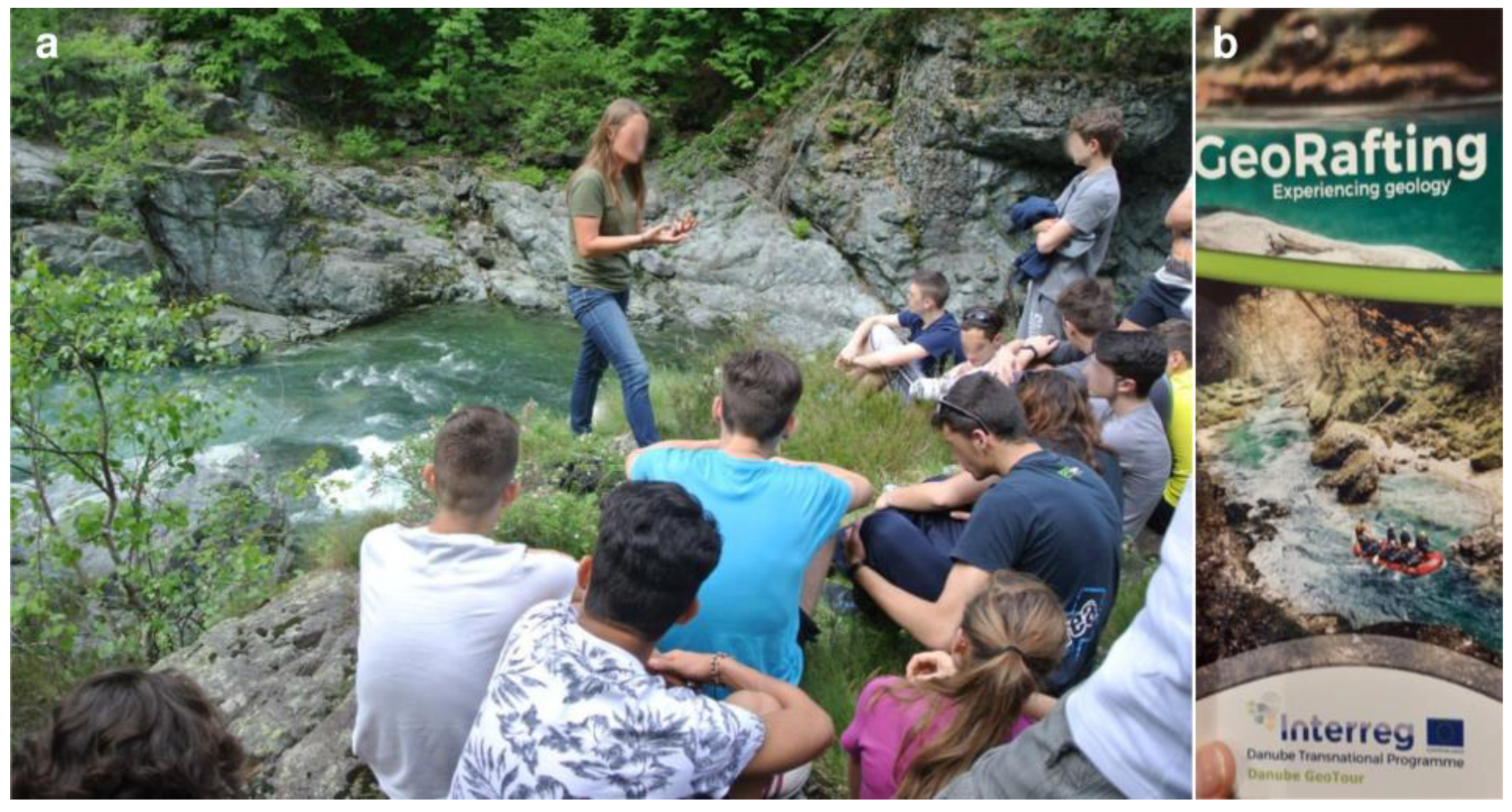

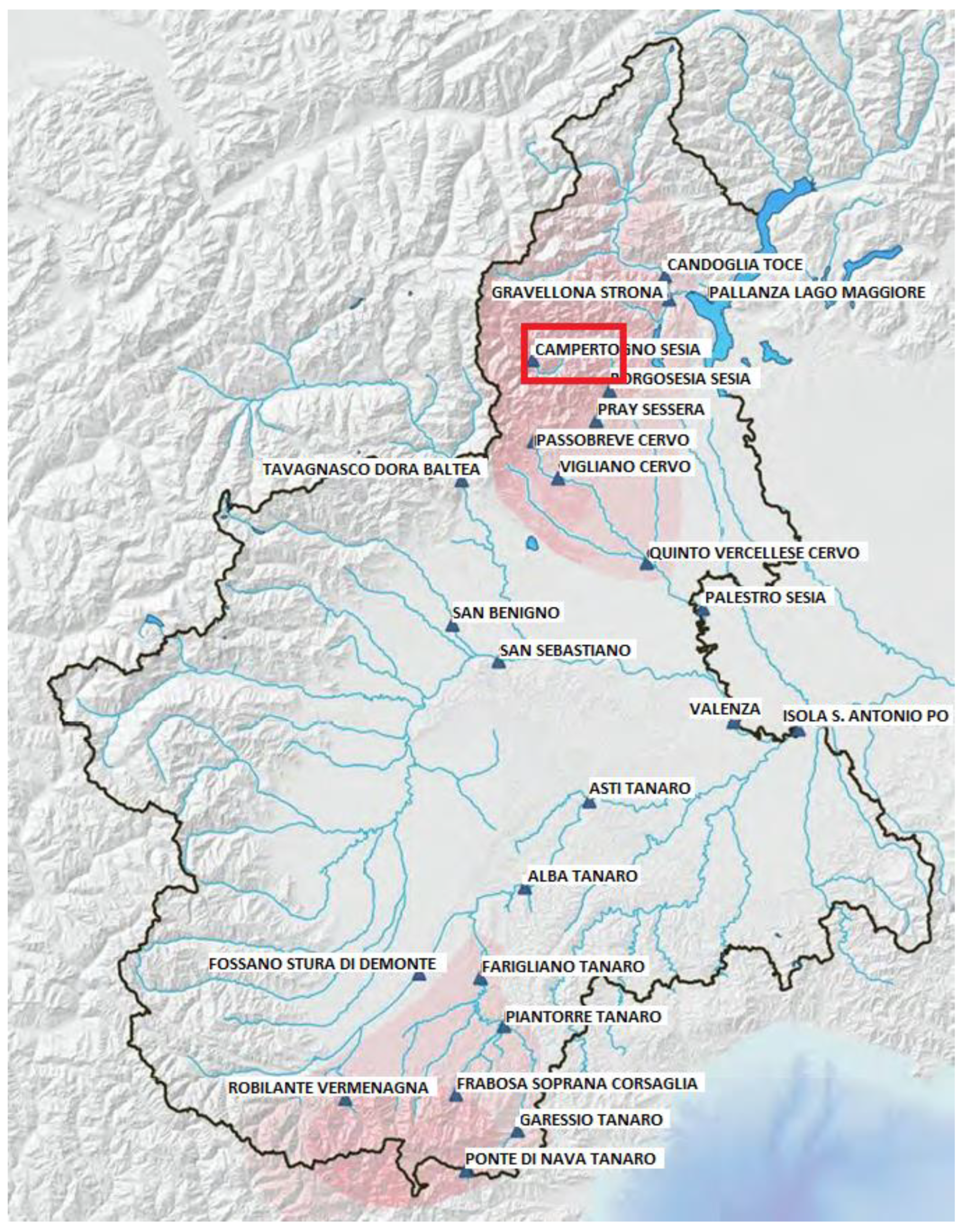

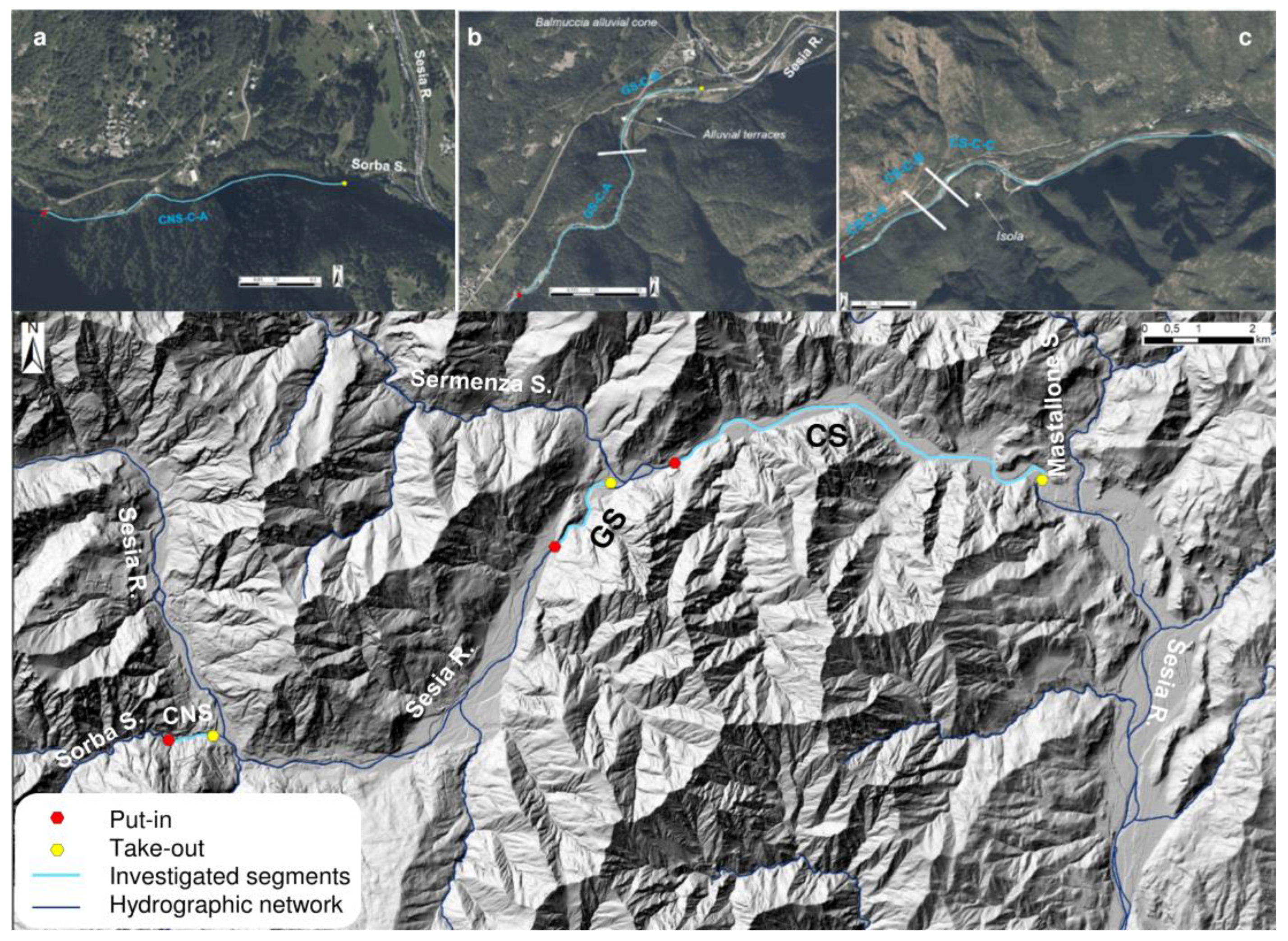
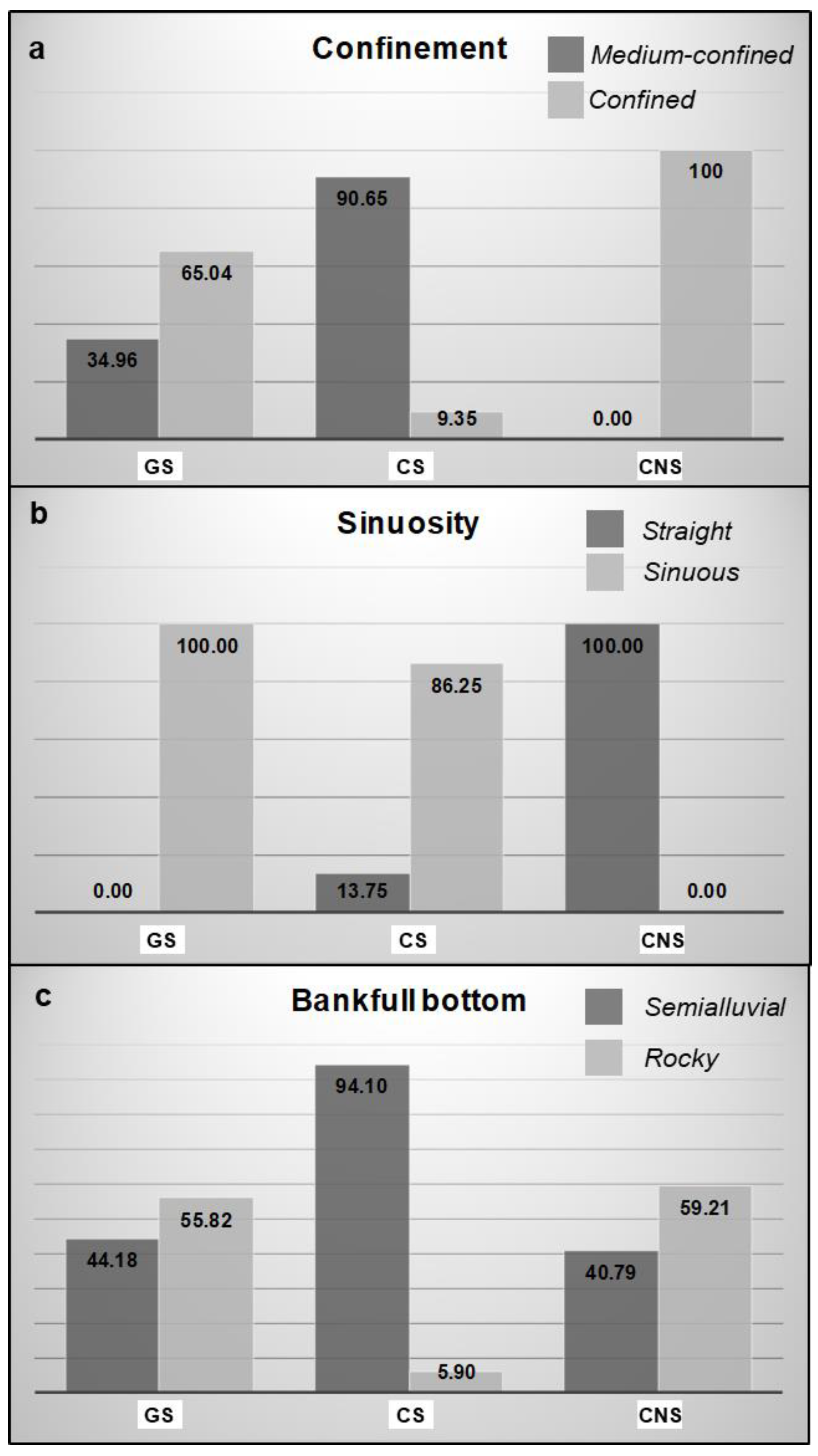
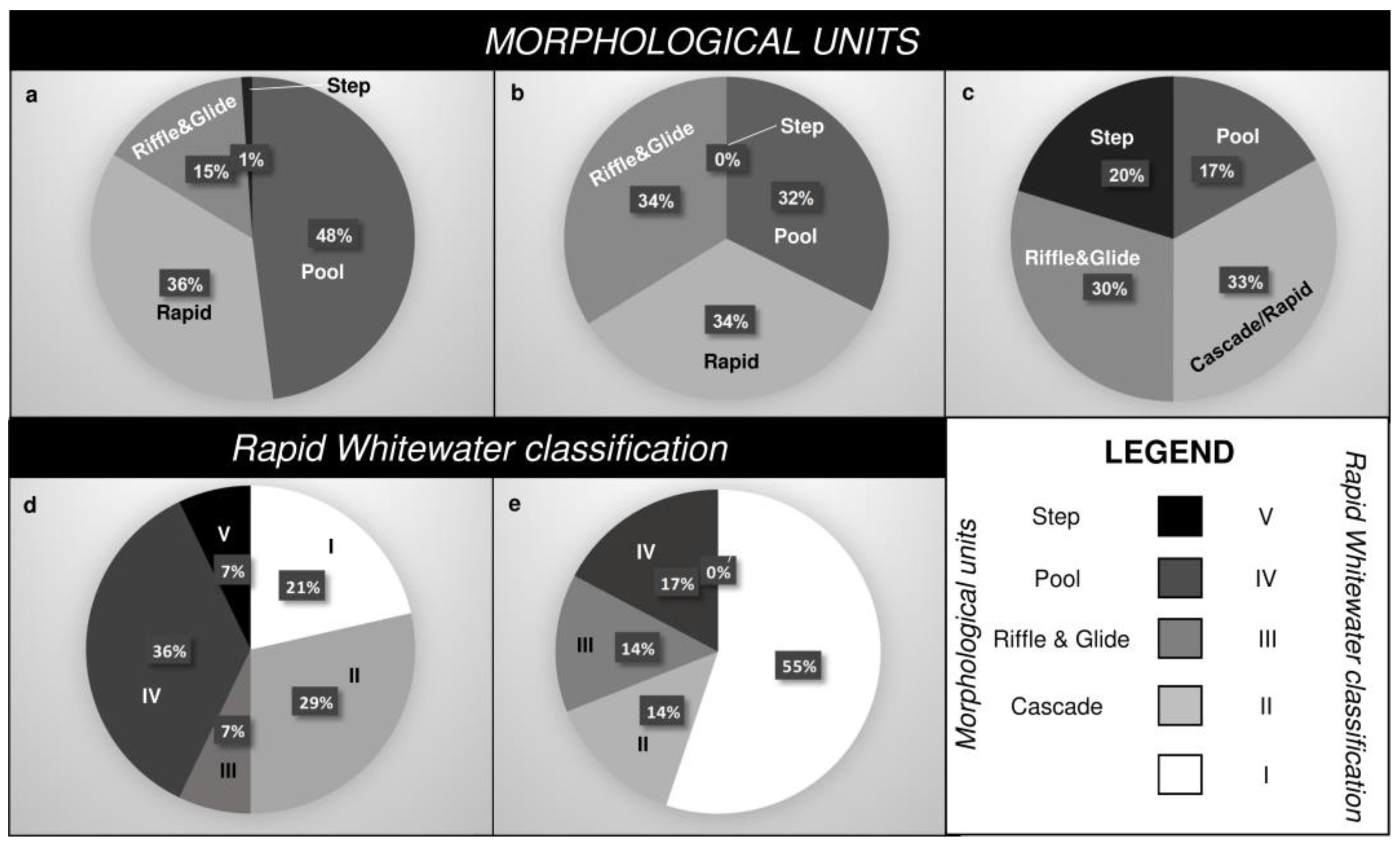


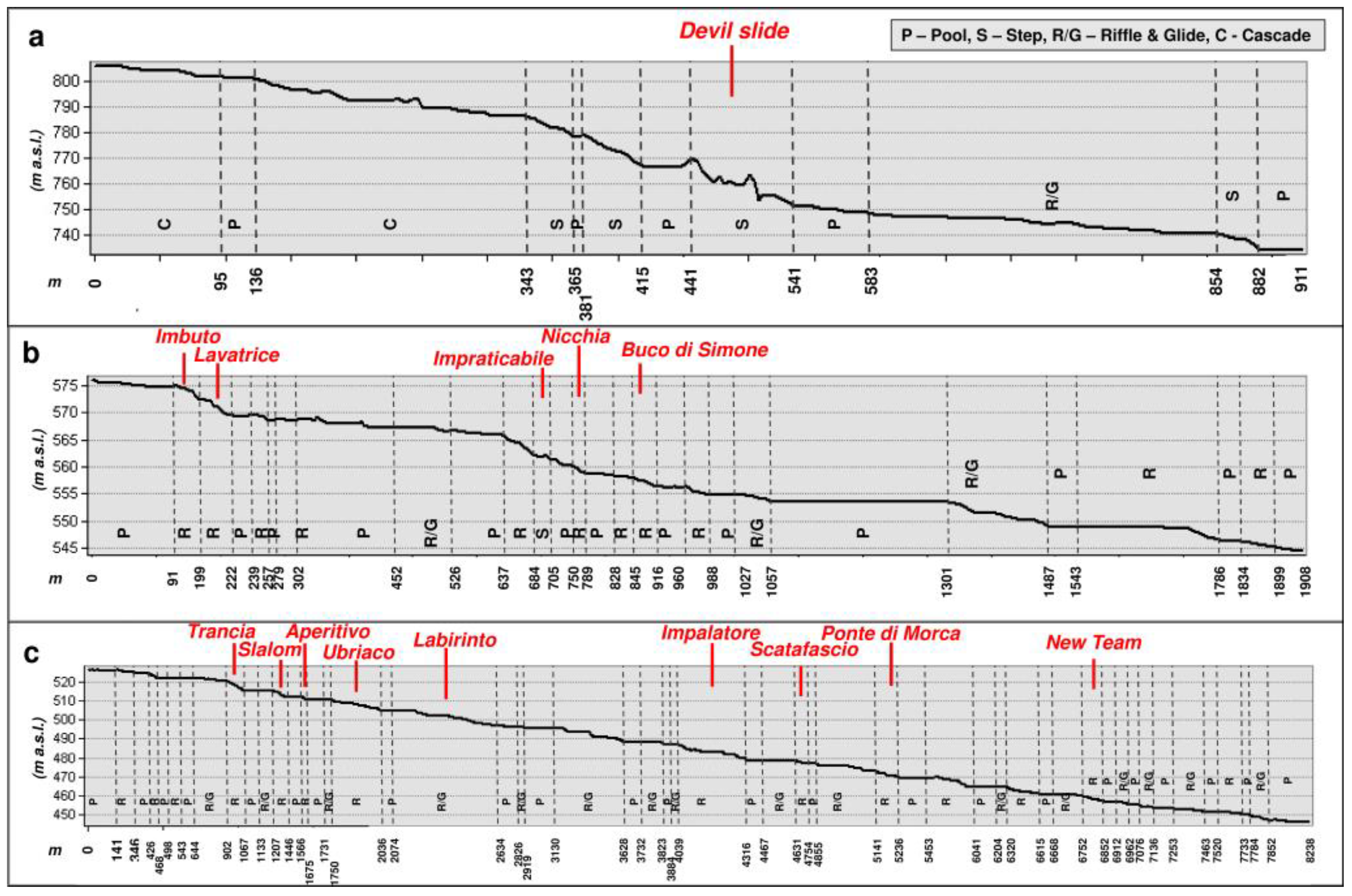
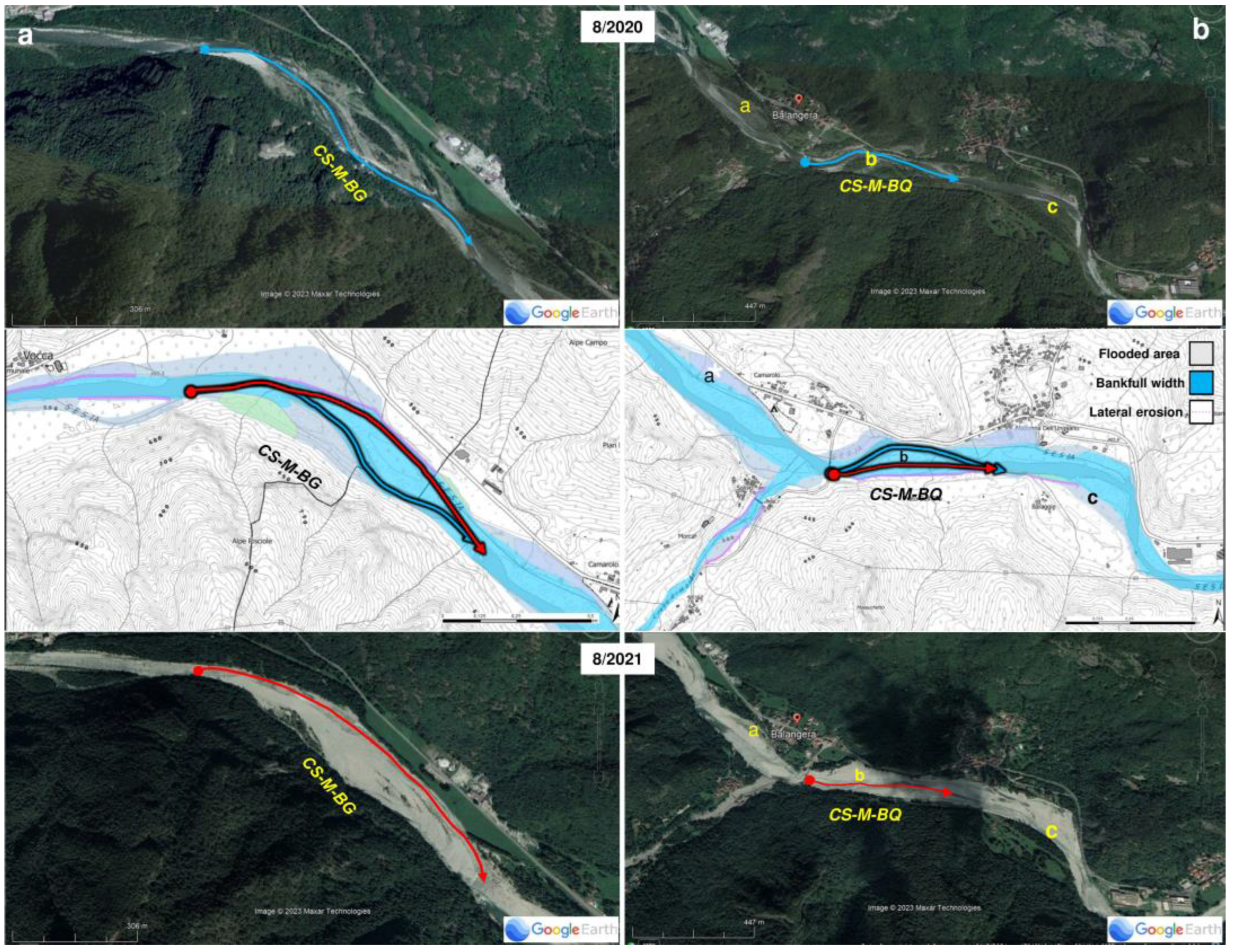
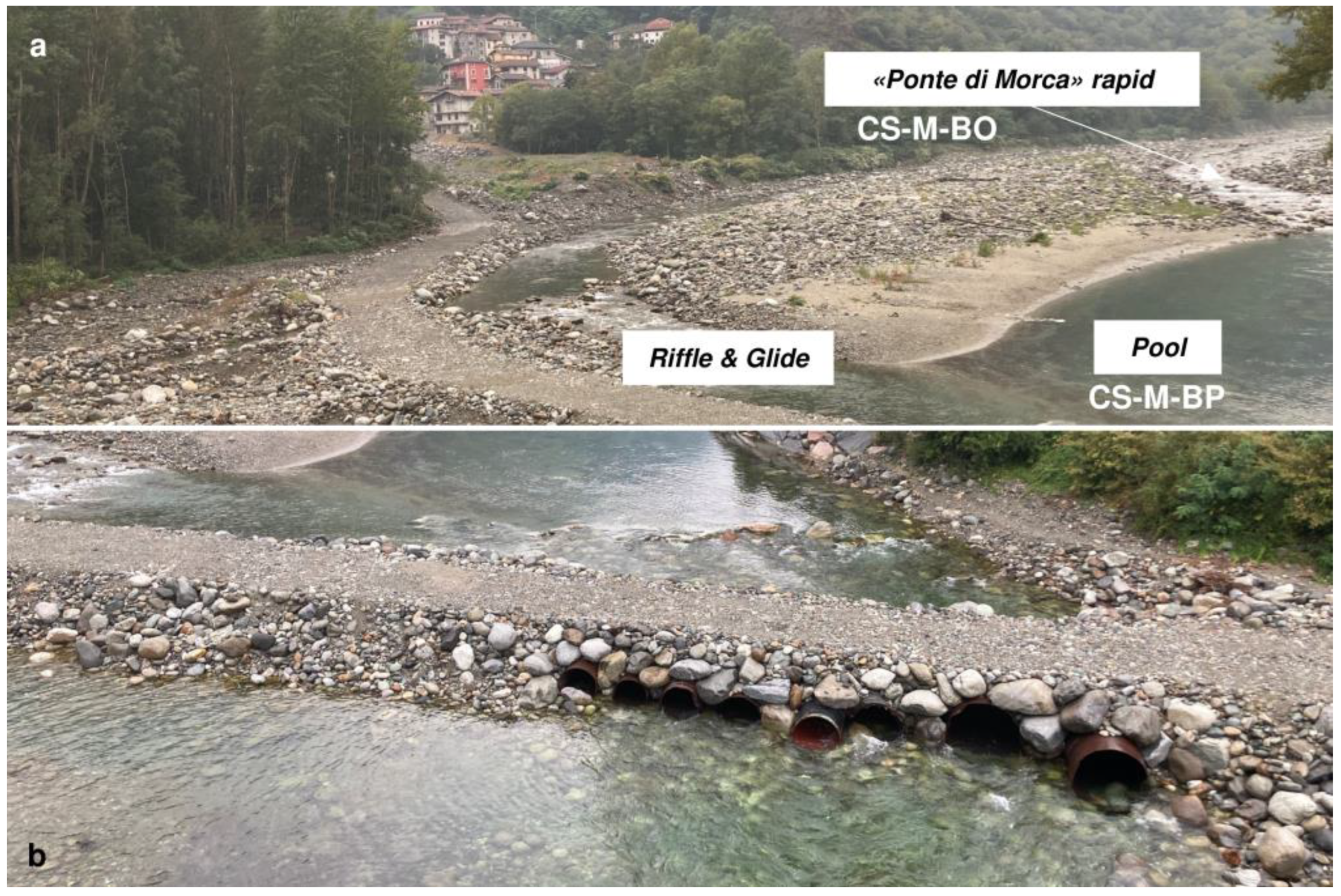

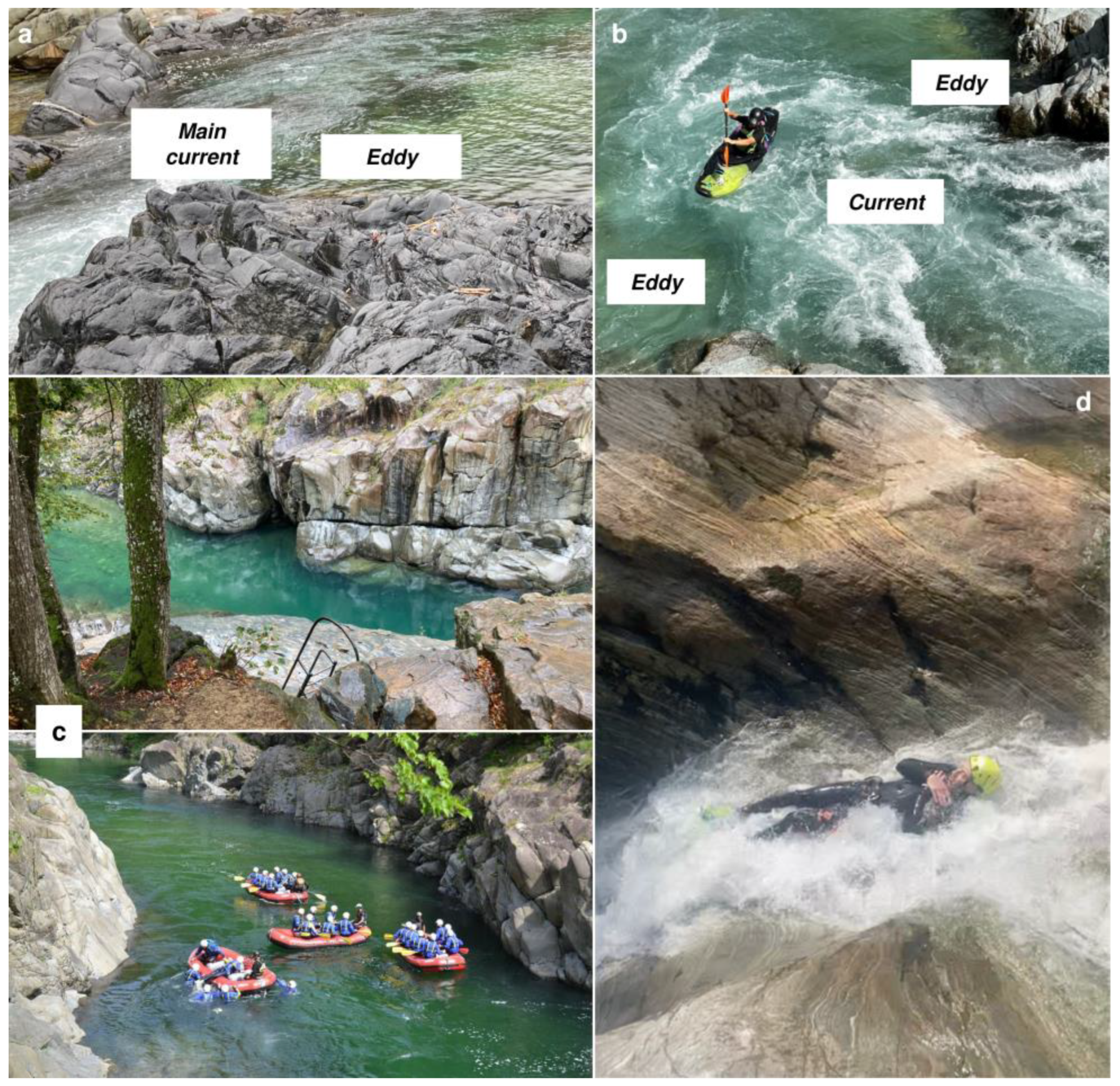
| N° | Name | Topic |
|---|---|---|
| 45 | Pietre Grosse | Huge landslide blocks |
| 20 | Gola dei Dinelli | Pseudotachylite breccia |
| 58 | Scopetta | Mylonite of the Insubric Line |
| 5 | Balmuccia | Geomorphological evidence of the Insubric Line |
| 41 | Peridotite di Balmuccia | One of the best-preserved mantle peridotites in the world |
| 23 | Isola di Vocca 1 | Crustal rocks incorporated in the Mafic Complex |
| 24 | Isola di Vocca 2 | High-temperature deformation of gabbro |
| 25 | Isola di Vocca 3 | Contact between mantle peridotite and Mafic Complex (beneath Cima Lavaggio) |
| 65 | Unipiano | Paleo-valley bottom during the Last Pleistocene Glaciation |
| Name | Provider | Type |
|---|---|---|
| Geological map (1:25,000) | Quick et al. [45] | Raster |
| Lithological map (1:100,000) | Arpa Piemonte | Vector |
| Sistema Informativo Fenomeni Franosi Regione Piemonte (SiFraP) | Arpa Piemonte | Vector |
| Alluvial fan database | Arpa Piemonte | Vector |
| BDE—Banca Dati Eventi Piemonte region | Arpa Piemonte | Vector |
| Database of the effect of the 2020 event | Arpa Piemonte | Web Map Service |
| GEmMA—GEodatabase Water stream morphology in Piemonte | Arpa Piemonte | Web Map Service |
| Aerial photograph 2010 and 2018 | Piemonte region | Web Map Service |
| BDTRE (Banca Dati Territoriale di Riferimento degli Enti) (1:10.000) | Piemonte region | Web Map Service |
| DTM-Digital Terrain Model(2009–2011; 5 m resolution) | Piemonte region | Raster |
| Name | Hydrography Basin Area (km2) | Length (km) | Outdoor Activity |
|---|---|---|---|
| Sesia river | 3037.6 | 139.6 | Rafting |
| Sorba stream | 46.9 | 12.1 | Canyoning |
| Name | River | Length (km) | Altitude Range (m a.s.l.) |
| Gole del Sesia (GS) | Sesia River | 1.908 | 545–575 |
| Classico del Sesia (CS) | Sesia River | 8.238 | 430–525 |
| Canyoning Sorba (CNS) | Sorba stream | 0.911 | 730–810 |
| Rafting | ||
|---|---|---|
| Difficulty | Target User | Description |
| I | General users | Small risks to swimmers, and self-rescue is easy. In this category, for the purposes of this research, the riffles and glides are also inserted, being the almost-zero vulnerability due to impossibility to swim into. |
| II | Novice | Swimmers are seldom injured, and group assistance is seldom needed. |
| III | Intermediate | Injuries while swimming are rare. Self-rescue is moderate, and group rescue can be required to avoid long swims. |
| IV | Advances | Risk of injury is moderate-to-high. Self-rescue can be difficult and practiced group rescue is often essential |
| V | Expert | Swimming is dangerous with a high risk of injury. Rescue is difficult, even for experts. |
| Canyoning | ||
| Parameter | Description | |
| Vertical character | Grades from 1 to 7, for the difficulty in the vertical character. It considers also the need of climbing to go down rocky steps. | |
| Aquatic character | Grades from 1 to 7, for the difficulty in the water character, including the need of swimming and the presence of relevant steps and toboggans | |
| Commitment | Grades from I to VI, considering the isolation of the canyon, the possibility to get out during floods, the first escape available after the beginning of the descent, the time occurring to approach, the descent and return, and, finally, the falling boulders. | |
| SDG | Action |
|---|---|
| 3—Good health and well-being | Physical activities improve the wellness of people. |
| 4—Quality education | Providing scientific contents to physical activities could be very involving and, additionally, attractive. |
| 5—Gender quality | Even more females should become trusted outdoor guides. |
| 8—Decent work and economic growth | Improve the employment opportunities for local guides, and the tourist sector of a region in general, widening the potential activities offered to different target users. |
| 11—Sustainable cities and Communities | Outdoor activities could help to increase the awareness of the value of natural resources in younger generations. |
| 13—Climate action | Through outdoor activities, people can explore the effects of climate change on landscapes and related natural hazards. |
| 17—Partnership | Outdoor activities can act as a bridge between UGGps, offering similar proposals in the view of exploring the geodiversity of Planet Earth, and, at local scale, between local operators. |
Disclaimer/Publisher’s Note: The statements, opinions and data contained in all publications are solely those of the individual author(s) and contributor(s) and not of MDPI and/or the editor(s). MDPI and/or the editor(s) disclaim responsibility for any injury to people or property resulting from any ideas, methods, instructions or products referred to in the content. |
© 2023 by the authors. Licensee MDPI, Basel, Switzerland. This article is an open access article distributed under the terms and conditions of the Creative Commons Attribution (CC BY) license (https://creativecommons.org/licenses/by/4.0/).
Share and Cite
Bollati, I.M.; Rossi, D.; Viani, C. Outdoor River Activities: Relations with Geological Background and Extreme Events in the Perspective of Geoeducation. Geosciences 2023, 13, 122. https://doi.org/10.3390/geosciences13040122
Bollati IM, Rossi D, Viani C. Outdoor River Activities: Relations with Geological Background and Extreme Events in the Perspective of Geoeducation. Geosciences. 2023; 13(4):122. https://doi.org/10.3390/geosciences13040122
Chicago/Turabian StyleBollati, Irene Maria, Davide Rossi, and Cristina Viani. 2023. "Outdoor River Activities: Relations with Geological Background and Extreme Events in the Perspective of Geoeducation" Geosciences 13, no. 4: 122. https://doi.org/10.3390/geosciences13040122
APA StyleBollati, I. M., Rossi, D., & Viani, C. (2023). Outdoor River Activities: Relations with Geological Background and Extreme Events in the Perspective of Geoeducation. Geosciences, 13(4), 122. https://doi.org/10.3390/geosciences13040122







